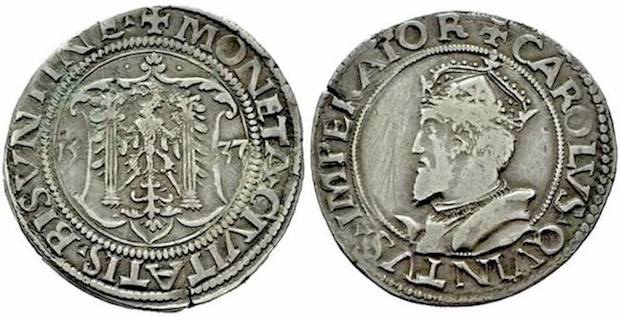
Teston 1537. Ø 28 mm, 8,80 g. PA 5382; Schulten 179. Obv.: + MONETA◂CIVITATIS◂BISVNTINE - arms between date 15 - 37 Rev.: +CAROLVS◂QVINTVS◂IMPERATOR - crowned bust in armor to the left. By convention, the obverse indicates the minting sovereign.
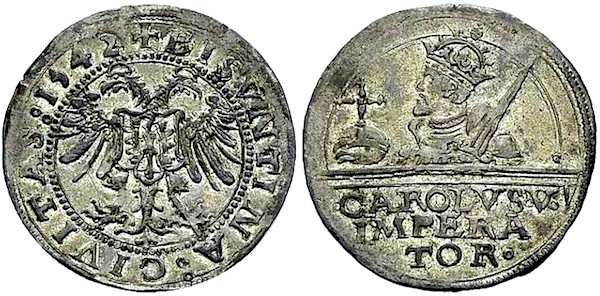
Gros (Goat) 1541. Billon, Ø 24 mm, 1,93 g. PA -; C/C/K M14/1541. Obv.: +BISVNTINA:CIVITAS:154I - double eagle with shines, city's arms on the breast. Rev.: crowned bust to the left, with orb and sword. Exergue: CAROLVS◦V◦ / IMPERA / TOR◦ Alloy with less than 50% silver is called billon.
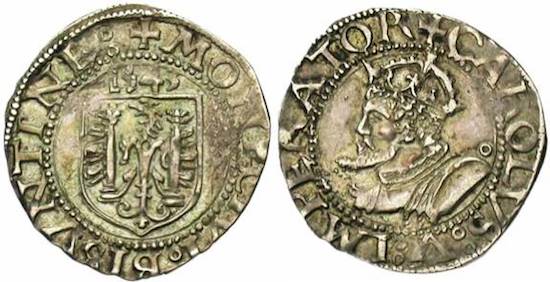
Carolus 1543. Billon, Ø 19 mm, 1,32 g. PA 5391; C/C/K M15/1543a. Obv.: +MONEta:CIVItatis:BISVNTINE: - shield with the arms of Besançon, on top the date 1545. Rev.: +CAROLVS:V:IMPERAROR - crowned bust in armor. The first Carolus coins are from 1537 ("pièce de deux blancs", PA 5383).
The ornate shield carrying the arms changed to a simple design in 1538.
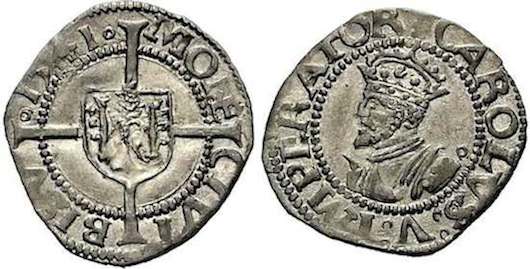
Blanc 1541. Billon, Ø ca.17 mm, ca.0,8 g. Typ PA pl.122/20. Obv.: MONE - CIVI - BISV - ⦂I54I - arms of Besançon over long cross. Rev.: +CAROLVS◦V◦IMPERATOR Poey d'Avant calls this coin "Petit blanc ou demi-blanc" (PA 5392, pl.122/20).
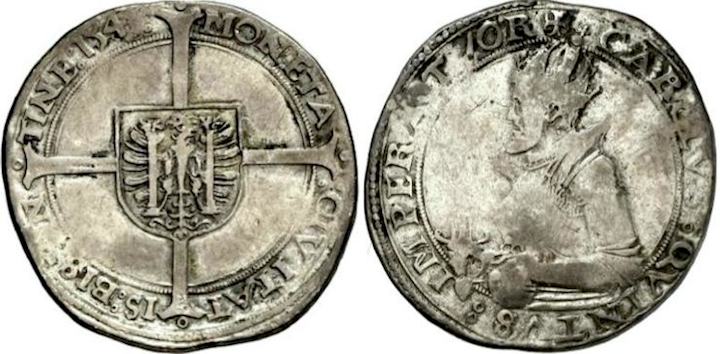
Franc 1543 (changed from 41 and 42). Ø 38 mm, 18,29 g. PA 5389; Dav.8940 (1541-2). Obv.: MONETA - CIVITAT - IS⦂BISVN - TINE⦂I543 - arms of Besançon over long cross. Rev.: +CAROLVS◦QVINTVS⦂IMPERATOR crowned half length effigy of the emperor, holding up a sword, with orb under the left hand. Poey d'Avant calls this piece from 1541 a "Ryndaldre" (19,00 g). Davenport presents only a drawing.
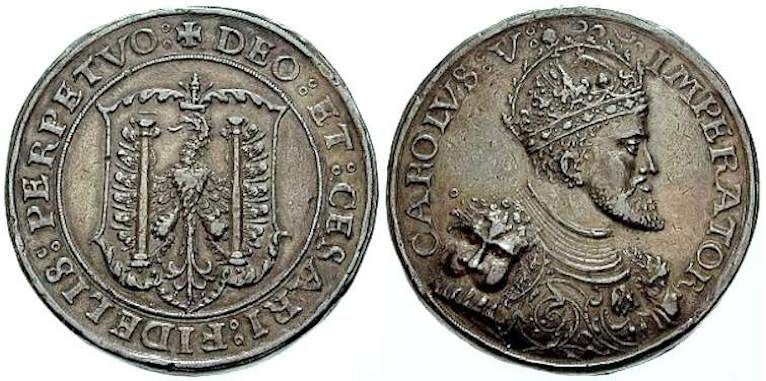
Double Schauthaler n. d. (1570). Ø 47 mm, 65,7 g. PA -; Dav.A8941. Obv.: + DEO:ET:CESARI:FIDELIS:PERPETVO "God and the emperor always faithful". arms in a garnished shield as usual in 1537 (compare the teston above). Rev.: CAROLVS:V: - IMPERATOR - crowned effigy in armor, the head of a lion on the shoulder. These pieces ("pièces du droit de général") are special for Besançon: The 14 governors of the city, in their role as overseer of the mint, were allotted such a piece each year as payment in kind. [Kü-194]
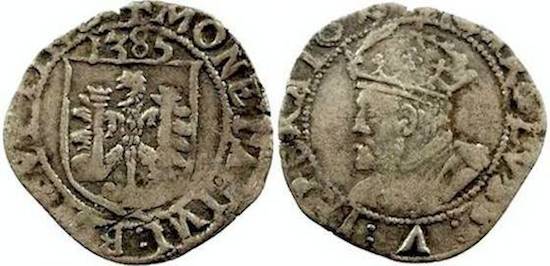
Carolus 1385 instead of 1583. Billon, Ø 19 mm, 0,91 g. C/C/K M15. + MONETA:CIVI:BISVNTINE // +CAROLVS:V:IMPERAROR While the Carolus was issued in virtually unchanged appearance over many decades, its silver content decreased continually. So many dies were needed that it is no wonder faulty ones also came into use.
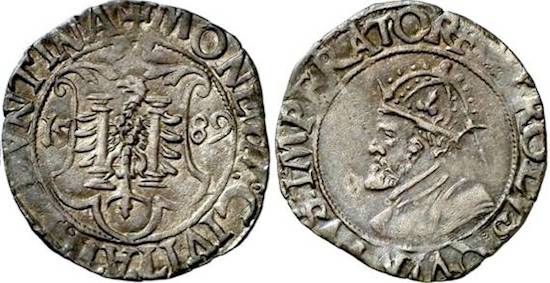
Carolus 1589. Billon, Ø ca.20 mm. PA 5401. + MONETA:CIVITA:BISVNTINA // +CAROLVS:QVINTVS:IMPERAROR arms in a garnished shield between date (as the teston at the first place). Beginning in 1617, Besançon printed "Imperial city" (Civitatis Imperialis) on their silver coins. 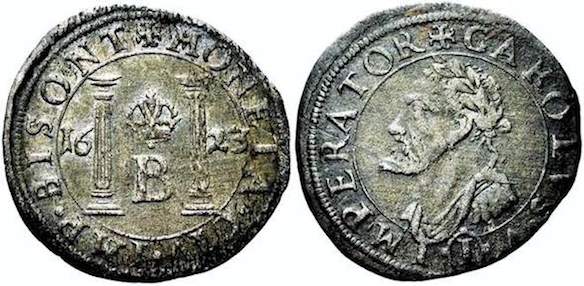
Gros 1623 = 1/8 Teston. AR, Ø 22 mm, 2,13 g. PA 5417; C.C.K.M14/1623. Obv.: + MONETA·CIV·IMP·BISONT - crowned B between two pillars and the date 16 - 23. Rev.: + CAROLVS·V·(1)·IMPERAROR - value 1 (groat) in a cartouche under the bust. This groat (in French "gros") was issued 1623-24.
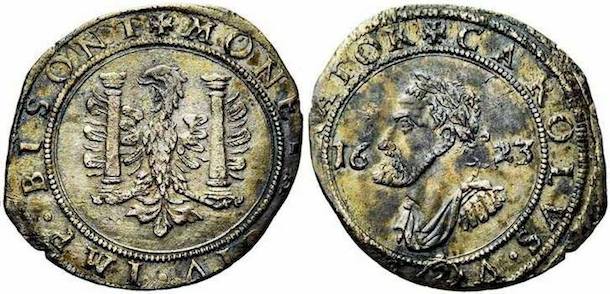
1/4 teston 1623. Ø ca.25 mm, 2,91 g. PA 5416; C/C/K M13/1623. Obv.: + MONETA·CIV·IMP·BISONT - city arms without shield. Rev.: +CAROLVS·V·(2)·IMPERAROR - bust between 16 - 23. value 2 (groats) in a cartouche under the bust. This 1/4 teston was issued 1623-24.
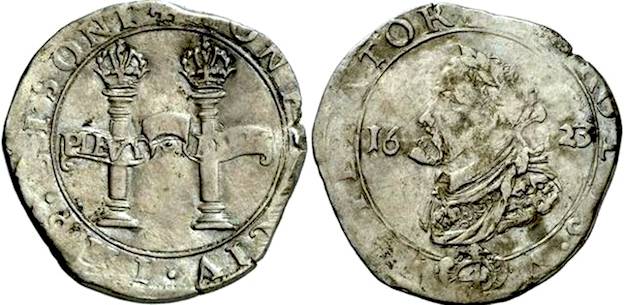
1/2 teston 1623. Ø ca.26 mm, 5,06 g. PA 5415, pl.123/16; C/C/K M12/1623. Obv.: + MONETA·CIV·IMP·BISONT two crowned pillars with banderole: PLEVT A DIEV "If God wills". Rev.: +CAROLVS·V·(4)·IMPERAROR - bust between date 16 - 23. Golden Fleece with collar on the breast; value 4 (groats) in a cartouche under the bust. This 1/2 teston was issued 1623-24.
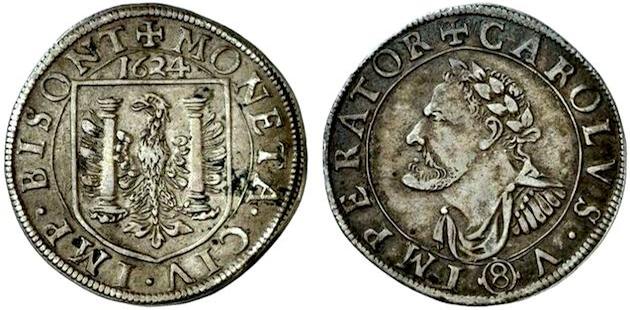
Teston 1624. Ø 28 mm, ca.7,8 g. PA 5414; C/C/K M11/1624. + MONETA·CIV·IMP·BISONT // +CAROLVS·V·(8)·IMPERAROR value 8 (groats) in a cartouche under the bust. This teston values 1/4 thaler as the thaler values 32 groats (see next coin).
It was issued 1622-24 & 1638-39. The value cartouche is missing in the final issue of 1640.
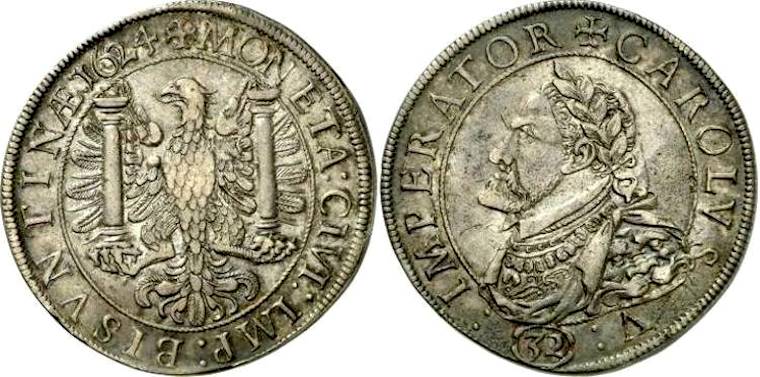
Thaler 1624. Ø ca.41 mm, 27,83 g. PA 5410; C/C/K M7/1624; Dav.5068. Obv.: + MONETA:CIVItatis:IMPerialis:BISVNTINÆ 1624 The arms of the city (without shield) completely fill in the circular field. Rev.: + CAROLVS - V: (32) :IMPERATOR - draped bust, head of a lion on the shoulder, collar and order of the Golden Fleece; value 32 (groats) in a cartouche at the bottom. This thaler was issued 1624-25. There is no value cartouche in the 2nd edition 1640-42.
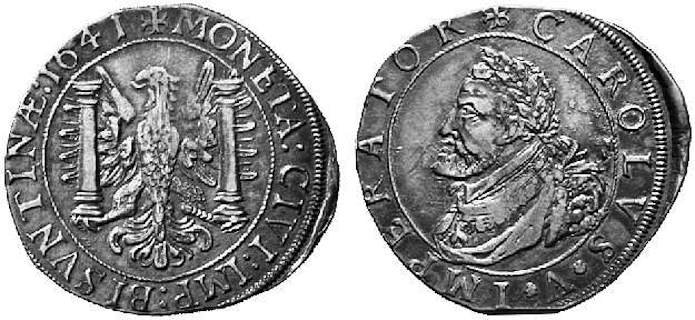
1/2 thaler 1641. Ø 34 mm, ca.13,9 g. PA 5412. Obv.: +MONETA:CIVItatis:IMPerialis:BISVNTINÆ 1641 - arms of the city as before. Rev.: +CAROLVS·V·IMPERATOR - bust as before. This 1/2 thaler was issued 1641-46. Its value in groats is not indicated.
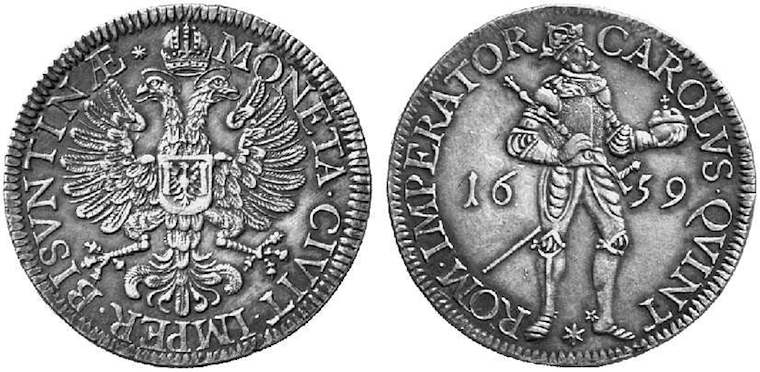
Thaler 1659. Ø 42 mm, 28,97 g. C/C/K M7/1659a; Dav.5070. MONETA·CIVIT·IMPER·BISVNTINÆ // CAROLVS·QVINT - ROM·IMPERATOR Obv.: double eagle with shines, city's arms on the breast. Rev.: crowned emperor, in armor and with scepter and orb, stands between the date 16 - 59. This thaler was issued 1658-67.
1/2 thalers and 1/4 Thalers of similar design were also issued (in 1662: ca. 35 mm; in 1661-64: 28 mm). The dies of the 1/4 thaler of 1644 were also used for the Pistole  of 1644. of 1644.Part 2 : gold coins on a separate page Lit:
|
| upgraded 10.2015 |
 start page
start page
